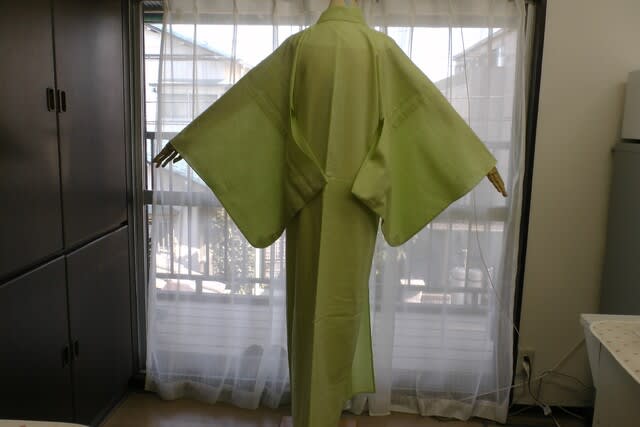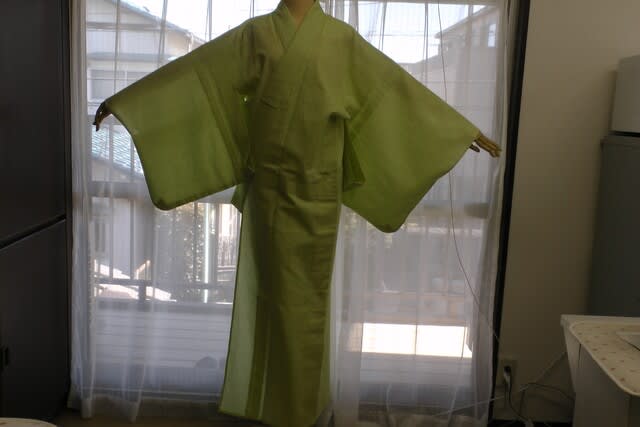Women's men's unisex yukata.女物と男物、男女兼用の浴衣。
この阿波しじらの男物の着物には袖の振りと人形が開いています。
※参照、男女の着物の違いとは?男物・女物それぞれの特徴を紹介。
浴衣としても着れる着物として創ったのでその方が脇から風が入って涼しいと考えました。
着物のサイズは着丈は肩から3尺9寸7分(150.1cm)裄1尺9寸5分(73.71cm)、後幅8寸(30.24cm)、前幅6寸5分(24.57cm)、衽幅4寸(15.12cm)です。
身長173cm、バスト90cm、ヒップ94cm位の方のサイズです。
男性の平均身長は女性より高くその分裄も長くなります。それに対して男性用の反物幅は広くはなりますが和裁的には十分では無いと考えています。
裄は袖幅と肩幅を足した長さなので、裄が長い時は出来るだけ袖幅を広げて肩幅を後幅プラス1寸(4cm)以下にします。
この着物を創る時に袖の割布が取れる長さの反物を選んだので袖幅を広くして肩幅と後幅を同寸にしました。
そうすることにより胸廻りの身幅を抑制出来ます。
(例)裄が1尺9寸5分(73.71cm)の時の肩幅と衽下りと袖付の処の後身頃の幅と前身頃の幅を比較します。
肩幅が9寸(34.02cm)の時の袖付の処の後身頃の幅は8寸(30.24cm)で前身頃の幅(抱幅)は6寸1分(23.06cm)です。
肩山から5寸7分5厘(21.74cm)の処の後身頃の幅は8寸6分2厘4毛(32.6cm)です。
衽下の処の前身頃の幅は6寸5分8厘(24.83cm)です。
肩幅と後幅が同寸の時の袖付の処の後身頃の幅も8寸(30.24cm)で前身頃の幅(抱幅)も6寸1分(23.06cm)です。
肩山から5寸7分5厘(21.74cm)の処の後身頃の幅は8寸1分1毛(30.62cm)です。
衽下りの処の前身頃の幅は6寸8毛(22.94cm)です。
後身頃の幅は5分2厘3毛(1.978cm)、前身頃の幅は5分(1.891cm)狭くなります。
蒸し暑い日本の夏には身幅がだぶつきにくい着物の方がさらりとと着れると思いこんな寸法にしました。
2万5千円で販売しています。
This Awa Shijira men's kimono has sleeves and a doll-shaped opening.
*See What are the differences between men's and women's kimonos? Introducing the characteristics of men's and women's kimonos.
I created this kimono so that it can be worn as a yukata, so it is cooler that way, as it allows air to enter from the sides.
The size of the kimono is 150.1 cm in length from the shoulder, 73.71 cm in sleeve width, 30.24 cm in back width, 24.57 cm in front width, and 15.12 cm in collar width.
It is the size for someone who is about 173 cm tall, with a bust of 90 cm and hips of 94 cm.
On average, men are taller than women, and therefore the sleeves are longer. On the other hand, the width of the cloth for men is wider, but I don't think it is enough for Japanese sewing.
The sleeve width is the sum of the sleeve width and shoulder width, so if the sleeve width is long, widen the sleeve width as much as possible and make the shoulder width no more than the back width plus 4 cm.
When making this kimono, I chose a bolt of fabric that was long enough to allow for the sleeve split, so I made the sleeves wider and the shoulder width and back width the same size.
By doing so, I was able to keep the width around the chest down.
(Example) Compare the shoulder width, the width of the back body where the collar and sleeves are attached, and the width of the front body when the sleeve width is 73.71 cm.
When the shoulder width is 34.02 cm, the width of the back body where the sleeves are attached is 30.24 cm, and the width of the front body (embracing width) is 23.06 cm.
The width of the back body at the collar 21.74 cm from the shoulder is 32.6 cm.
The width of the front body at the collar is 24.83 cm.
When the shoulder width and back width are the same size, the width of the back body where the sleeves are attached is also 30.24 cm, and the width of the front body (embracing width) is also 23.06 cm. The width of the back body at the point 21.74cm from the shoulder is 30.62cm.
The width of the front body at the collar is 22.94cm.
The width of the back body is 1.978cm, narrower than the front body by 1.891cm.
I chose these measurements because I thought a kimono that is less loose would be more comfortable to wear in the hot and humid Japanese summer.
It is on sale for 25,000 yen.


この阿波しじらの男物の着物には袖の振りと人形が開いています。
※参照、男女の着物の違いとは?男物・女物それぞれの特徴を紹介。
浴衣としても着れる着物として創ったのでその方が脇から風が入って涼しいと考えました。
着物のサイズは着丈は肩から3尺9寸7分(150.1cm)裄1尺9寸5分(73.71cm)、後幅8寸(30.24cm)、前幅6寸5分(24.57cm)、衽幅4寸(15.12cm)です。
身長173cm、バスト90cm、ヒップ94cm位の方のサイズです。
男性の平均身長は女性より高くその分裄も長くなります。それに対して男性用の反物幅は広くはなりますが和裁的には十分では無いと考えています。
裄は袖幅と肩幅を足した長さなので、裄が長い時は出来るだけ袖幅を広げて肩幅を後幅プラス1寸(4cm)以下にします。
この着物を創る時に袖の割布が取れる長さの反物を選んだので袖幅を広くして肩幅と後幅を同寸にしました。
そうすることにより胸廻りの身幅を抑制出来ます。
(例)裄が1尺9寸5分(73.71cm)の時の肩幅と衽下りと袖付の処の後身頃の幅と前身頃の幅を比較します。
肩幅が9寸(34.02cm)の時の袖付の処の後身頃の幅は8寸(30.24cm)で前身頃の幅(抱幅)は6寸1分(23.06cm)です。
肩山から5寸7分5厘(21.74cm)の処の後身頃の幅は8寸6分2厘4毛(32.6cm)です。
衽下の処の前身頃の幅は6寸5分8厘(24.83cm)です。
肩幅と後幅が同寸の時の袖付の処の後身頃の幅も8寸(30.24cm)で前身頃の幅(抱幅)も6寸1分(23.06cm)です。
肩山から5寸7分5厘(21.74cm)の処の後身頃の幅は8寸1分1毛(30.62cm)です。
衽下りの処の前身頃の幅は6寸8毛(22.94cm)です。
後身頃の幅は5分2厘3毛(1.978cm)、前身頃の幅は5分(1.891cm)狭くなります。
蒸し暑い日本の夏には身幅がだぶつきにくい着物の方がさらりとと着れると思いこんな寸法にしました。
2万5千円で販売しています。
This Awa Shijira men's kimono has sleeves and a doll-shaped opening.
*See What are the differences between men's and women's kimonos? Introducing the characteristics of men's and women's kimonos.
I created this kimono so that it can be worn as a yukata, so it is cooler that way, as it allows air to enter from the sides.
The size of the kimono is 150.1 cm in length from the shoulder, 73.71 cm in sleeve width, 30.24 cm in back width, 24.57 cm in front width, and 15.12 cm in collar width.
It is the size for someone who is about 173 cm tall, with a bust of 90 cm and hips of 94 cm.
On average, men are taller than women, and therefore the sleeves are longer. On the other hand, the width of the cloth for men is wider, but I don't think it is enough for Japanese sewing.
The sleeve width is the sum of the sleeve width and shoulder width, so if the sleeve width is long, widen the sleeve width as much as possible and make the shoulder width no more than the back width plus 4 cm.
When making this kimono, I chose a bolt of fabric that was long enough to allow for the sleeve split, so I made the sleeves wider and the shoulder width and back width the same size.
By doing so, I was able to keep the width around the chest down.
(Example) Compare the shoulder width, the width of the back body where the collar and sleeves are attached, and the width of the front body when the sleeve width is 73.71 cm.
When the shoulder width is 34.02 cm, the width of the back body where the sleeves are attached is 30.24 cm, and the width of the front body (embracing width) is 23.06 cm.
The width of the back body at the collar 21.74 cm from the shoulder is 32.6 cm.
The width of the front body at the collar is 24.83 cm.
When the shoulder width and back width are the same size, the width of the back body where the sleeves are attached is also 30.24 cm, and the width of the front body (embracing width) is also 23.06 cm. The width of the back body at the point 21.74cm from the shoulder is 30.62cm.
The width of the front body at the collar is 22.94cm.
The width of the back body is 1.978cm, narrower than the front body by 1.891cm.
I chose these measurements because I thought a kimono that is less loose would be more comfortable to wear in the hot and humid Japanese summer.
It is on sale for 25,000 yen.


















